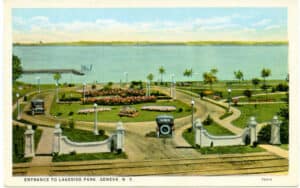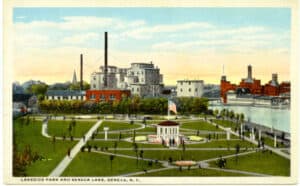Lakeside Park
(From April 1996 Historical Society Newsletter)
Despite the charms of Seneca Lake and the fascination its deep waters hold, Genevans did not begin to clamor for public spaces along the waterfront until after the Civil War. In fact it was not until the shoreline was threatened by the Syracuse, Geneva, and Corning Railroad in the late 1870s more than a few voices argued for halting commercial and industrial development on the lake. Those voice were the first to suggest that the never-ending industrial development and its consequences on Geneva might not all be good.

Entrance to Lakeside Park
The placement of the railroad rails aside, it was not until the late 1890s that Geneva village authorities began to talk publicly about parkland, a time when the railroads, commercial structures such as warehouses, and industry possessed the waterfront almost completely. National trends were towards the installation of parks in major cities throughout the East and Midwest, designed by landscape architects such as Frederick Law Olmstead. By the end of the 19th century, a progressive impulse to create open space for urban workers who could not easily travel to the peace and quiet of rural areas had also begun to influence park development.
The first annual report of the Geneva Board of Public Works admitted in 1898 that the city owned no waterfront land which it could devote to a park, though it al noted that Geneva needed a public park for both its residents and visitors. Street improvements were the priority and until completed, the fiscal responsibility of obtaining and maintaining land for a park could not be considered.
By 1900, the Board was still concentrating on efforts to pave the streets as well as to extend the towpath, allowing access to the lakefront for the purposes of unloading paving stone from canal barges. The next year, a park was again mentioned in the annual report, but only if land was donated by property owners.

Lakeside Park, ca. 1925
By 1903, however, the issue of a park begins to appear in the forefront of the thinking by city officials, who believed that over a period of years it may be possible to create a public gathering place or plaza along the shores with shrubbery and trees. Manufacturing facilities would not have to move to make way for the park, though “at some future time they may voluntarily do so.” The board set to work acquiring some of the property along the lakefront, while it still could be cheaply purchased. Opposition to the proposal was strong, with arguments regarding the monies about to be wasted on the park when road improvements and other issues were deemed far more critical. But in August 1904 a resolution was passed calling the lake front as it was at the time “an unsightly blemish on the City of Geneva and bids fair to remain as such unless action is taken by some property constituted authority.”
By January 1905, a petition had gone to the state legislature to grant the City a portion of the land. The petition was approved in March and bonds were floated to provide the funds necessary to buy the shoreline property owners out. A complicated series of lawsuit followed over land rights (including agreements over who owned the land under the water) and ownership and it was not until 1916 that Lakeside Park was formally opened.
As planned, the park covered 3.1 acres and had a frontage of 570 feet along the water. Its width varied from 160 feet to 250 feet “owing to the irregular line of the track of the New York Central and Hudson River Railroad Company.” It occupied lands between the railroad tracks and the lake, the entrance being located at the base of Castle Street. The park was bordered by Patent Cereals factory and another factory (just north of Franklin Alley). During the time between 1905 and the formal dedication of the park, work had been done on planting shrubs and a row of Carolina poplars (all donated by local nurseries) and filling in the land with debris and rubble excavated during the process of paving Geneva’s streets.
 Lakeside Park was developed, and it continued to be popular spot well into the 1940s. Its highly manicured landscape was a frequent subject of color postcards of the city and many still remember the park’s pond, always stocked with enormous goldfish. In the 1940s band concerts were frequently held there, the bandstand in the middle of the park often decorated with flowers or bunting, and in the evening, color electric lights were strung. In June 1929, the Geneva Park Band played one evening, which the newspaper stated was “an ideal one for such a concert. The Lakeside Park with its beautiful grounds, shrubbery and flowers was never more attractive. The full moon shining over the quiet waters of the lake made a setting for the event that added to the enjoyment.
Lakeside Park was developed, and it continued to be popular spot well into the 1940s. Its highly manicured landscape was a frequent subject of color postcards of the city and many still remember the park’s pond, always stocked with enormous goldfish. In the 1940s band concerts were frequently held there, the bandstand in the middle of the park often decorated with flowers or bunting, and in the evening, color electric lights were strung. In June 1929, the Geneva Park Band played one evening, which the newspaper stated was “an ideal one for such a concert. The Lakeside Park with its beautiful grounds, shrubbery and flowers was never more attractive. The full moon shining over the quiet waters of the lake made a setting for the event that added to the enjoyment.
But by 1951, it was clear that the park had been neglected for some time. As the arterial highway was built through the area, the city clearly envisioned that the land between the towpath extension and the arterial causeway would extend the area of Lakeside Park. But the need to accommodate more parked cars downtown appears to have taken precedence. By 1959, the parking lot materialized and Lakeside Park became a fond memory for many Genevans.
